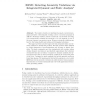Free Online Productivity Tools
i2Speak
i2Symbol
i2OCR
iTex2Img
iWeb2Print
iWeb2Shot
i2Type
iPdf2Split
iPdf2Merge
i2Bopomofo
i2Arabic
i2Style
i2Image
i2PDF
iLatex2Rtf
Sci2ools
119
click to vote
FASE
2009
Springer
2009
Springer
HAVE: Detecting Atomicity Violations via Integrated Dynamic and Static Analysis
Abstract. The reality of multi-core hardware has made concurrent programs pervasive. Unfortunately, writing correct concurrent programs is difficult. Atomicity violation, which is caused by concurrently executing code unexpectedly violating the atomicity of a code segment, is one of the most common concurrency errors. However, atomicity violations are hard to find using traditional testing and debugging techniques. This paper presents a hybrid approach that integrates static and dynamic analyses to attack this problem. We first perform static analysis to obtain summaries of synchronizations and accesses to shared variables. The static summaries are then instantiated with runtime values during dynamic executions to speculatively approximate the behaviors of branches that are not taken. Compared to dynamic analysis, the hybrid approach is able to detect atomicity violations in unexecuted parts of the code. Compared to static analysis, the hybrid approach produces fewer false alarms. We...
Related Content
| Added | 19 May 2010 |
| Updated | 19 May 2010 |
| Type | Conference |
| Year | 2009 |
| Where | FASE |
| Authors | Qichang Chen, Liqiang Wang, Zijiang Yang, Scott D. Stoller |
Comments (0)

